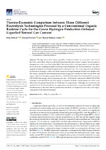Thermo-Economic Comparison between Three Different Electrolysis Technologies Powered by a Conventional Organic Rankine Cycle for the Green Hydrogen Production Onboard Liquefied Natural Gas Carriers

Use this link to cite
http://hdl.handle.net/2183/38977
Except where otherwise noted, this item's license is described as Creative Commons Attribution (CC BY) license
Collections
Metadata
Show full item recordTitle
Thermo-Economic Comparison between Three Different Electrolysis Technologies Powered by a Conventional Organic Rankine Cycle for the Green Hydrogen Production Onboard Liquefied Natural Gas CarriersDate
2024Citation
Elrhoul, D.; Naveiro, M.; Romero Gómez, M. Thermo-Economic Comparison between Three Different Electrolysis Technologies Powered by a Conventional Organic Rankine Cycle for the Green Hydrogen Production Onboard Liquefied Natural Gas Carriers. Journal of Marine Science and Engineering. 2024, 12, 1287. https://doi.org/10.3390/jmse12081287
Abstract
[Abstract] The high demand for natural gas (NG) worldwide has led to an increase in the size of the LNG carrier fleet. However, the heat losses from this type of ship’s engines are not properly managed, nor is the excess boil-off gas (BOG) effectively utilised when generation exceeds the ship’s power demand, resulting in significant energy losses dissipated into the environment. This article suggests storing the lost energy into green H2 for subsequent use. This work compares three different electrolysis technologies: solid oxide (SOEC), proton exchange membrane (PEME), and alkaline (AE). The energy required by the electrolysis processes is supplied by both the LNG’s excess BOG and engine waste heat through an organic Rankine cycle (ORC). The results show that the SOEC consumes (743.53 kW) less energy while producing more gH2 (21.94 kg/h) compared to PEME (796.25 kW, 13.96 kg/h) and AE (797.69 kW, 10.74 kg/h). In addition, both the overall system and SOEC stack efficiencies are greater than those of PEME and AE, respectively. Although the investment cost required for AE (with and without H2 compression consideration) is cheaper than SOEC and PEME in both scenarios, the cost of the H2 produced by the SOEC is cheaper by more than 2 USD/kgH2 compared to both other technologies.
Keywords
SOEC
PEME
AE
gH2
ORC
ICE
PEME
AE
gH2
ORC
ICE
Editor version
Rights
Creative Commons Attribution (CC BY) license






